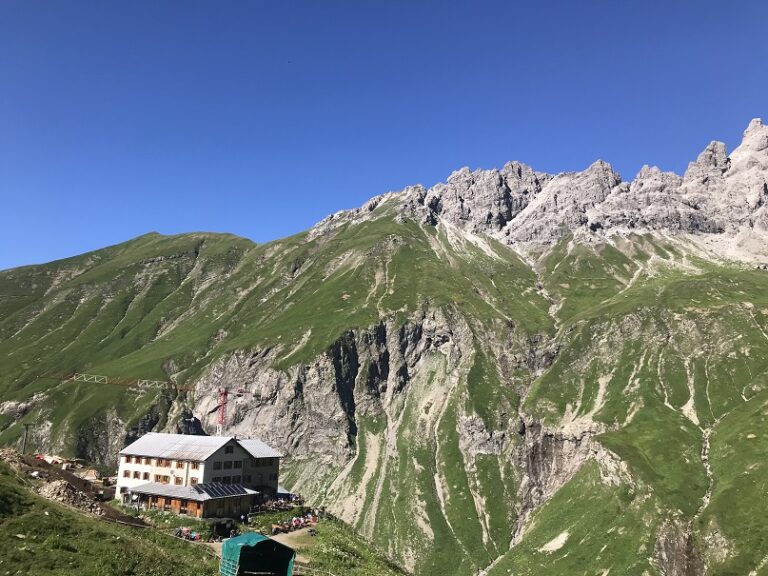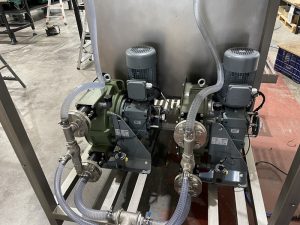Modified Progressing Cavity Pumps Reliably Move Wastewater down to the Valley

The Kemptner Hütte near Oberstdorf sits at an altitude of 1 844 m. As one of the largest huts of the DAV in the Allgäu Alps, it offers long distance hikers and other mountaineers respite and refuge surrounded by majestic peaks. (Image source: NETZSCH Pumpen & Systeme GmbH)
The Kemptner Hütte on the grassy slopes of the picturesque Allgäu Alps near Oberstdorf is one of the largest and most important mountain shelters of the German Alpine Club. Framed by craggy peaks which are over 2 400 m high, it is located between the two stations Oberstdorf and Memminger Hütte of the European Long Distance Hiking Trail E5 and at the access point to the Heilbronn Trail between Oberstdorf and the Rappensee Hütte – an ideal basis for multi day and long distance tours. It is therefore not surprising that the demand for overnight stays has been growing steadily over the years, pushing the hut built in 1891 to its limits. According to information from the DAV, the refurbishment measures were urgently required after the shelter had been barely able to cope with the number of guests in recent years. In addition to more kitchen and storage capacities for food and drink, living and communal areas for personnel, larger washrooms and an update to the fire safety installations, the wastewater handling also needed to be adapted in line with the current environmental regulations. The hut was consequently refurbished extensively between 2020 and 2022. To retain the character of a simple mountain refuge, however, the owners did not want to increase the capacity. Nevertheless, the wastewater handling of the hut, which sleeps 290 people, had to be completely redesigned: “There was no practical wastewater solution. The soak pit that had previously been in place near the hut would have been unable to cope in the future,” explains Olaf Textor, Head of Global Business Field Customer Service at NETZSCH Pumpen & Systeme. In addition to this, such a solution is also an environmental issue and pits of this size are no longer permitted as the wastewater would impact the surrounding nature. The owners of the hut therefore decided to build a new line that connects the wastewater collection point at the hut with the sewer system in the valley. The pumps required for this were ordered from the experts at NETZSCH, who have already successfully implemented similar solutions in mountain areas. The hut owners were impressed by the process optimised technology and in particular by the service and support portfolio of the partner, who went to great lengths to carry out the service work quickly and efficiently, despite the remote location.
Pumps and technicians transported to the hut by helicopter
“Planning and comprehensive service are crucial for a project of this magnitude,” explains Textor. “We are using our more than 70 years of experience in the field of customised pump systems to implement a sustainable solution even in challenging surroundings.” While pumps operated in the valley are subject to only little influence from the direct environment, the planners and technicians were faced with additional challenges due to the rough terrain, difficult topography and the remote character of the pump site. “It was a matter of course for us to provide support and advice from the first day,” adds the Head of Global Business Field Customer Service. In preparation for the refurbishment work, it was first necessary to transport construction machinery and materials to the mountain by helicopter. At the same time, the sections of the building earmarked for demolition in the first phase were cleared while NETZSCH took stock of the situation on site for preparing a suitable pump design together with the owners. They decided to install two NEMO progressing cavity pumps with a capacity of approx. 5.40 m³/h, which would transport the generated wastewater into the valley through a more than two kilometres long line with a pressure of 15.9 bar. Both pumps were airlifted to the hut and installed.
As the cabin had no previous experience of using wastewater pumps, it was difficult to estimate what impact the composition and quantity of the wastewater would have on the pumps. “Unfortunately it happens only all too frequently that guests dispose of items through the toilets that do not belong there and can cause blockages,” describes Textor. Even hair that gets into the wastewater through the shower drains can increase the solids content and cause clogging. “To ensure that this will not damage the pumps permanently, we also placed a great focus on the timing for the maintenance work in this project. This means that the users do not have to worry about long waiting times and we keep original spare parts in stock at all times.”
Clogging as the greatest challenge on the mountain
After the pumps initially ran without issues for a while, the hut owners reported a motor defect that they were unable to explain. NETZSCH immediately sent technicians to the hut to eliminate the defect. Upon closer inspection of the pumps, they found clogs and a valve that was not closing. “Hair had clogged the check valve so that the pump no longer sealed,” reports Textor. “As a result, it was running in reverse to compensate for the pressure, which took a toll on the motor when the pump started up. In the end, this caused the pump motor to fail.”
Modified housing and motor prevent clogging
Once the owners had gained an understanding of the performance and the actual burden on the pump, a technician visited the hut to modify the two pumps based on the owners’ information. “Clogging is still a problem that can occur in a setting like this. We therefore installed a new pump housing with larger flanges during this service call,” explains the Head of Global Business Field Customer Service. This makes the pumps much easier to clean and personnel at the hut can independently remove clogs quickly. In addition to this, the previously used drive was replaced with an electric motor with a brake that cannot be activated by the backflow. To also protect the coupling rods against clogs, the joints were additionally equipped with silicone sleeves. These measures not only increase the performance, but also have a positive impact on the service life of the wastewater pumps. With the motor having to compensate for resistance less frequently, the overall performance improves, making the entire wastewater handling process even more sustainable. At the end of the service call, however, the weather was not cooperating and prevented the helicopter from flying back the technician and the removed parts. “Our technician was then able to experience the new shelter for himself, having to spend two nights at the hut before the conditions improved enough for a descent on foot. The materials were transported down to the valley with a material ropeway,” Textor recounts.
Pumps running smoothly since the conversion
Just in time for the official opening of the hut at the start of the season, the first guests were able to experience the larger room layout, the optimised washrooms and the modern wastewater handling. Thanks to the efforts of NETZSCH and the construction firms involved, the mountaineers are unaware that the wastewater now no longer ends up in a soak pit, but instead is pumped down to the valley in a reliable and eco-friendly process. It could not have gone any better for the hut owners: Careful planning made it possible to set up and optimise a pump solution that runs reliably and yet can be easily operated, serviced and unclogged by the personnel on site. At the same time they know that NETZSCH will travel all the way to the hut again if necessary. “This service call once again proved that technology alone is not enough to ensure optimum results in the long term. It is experience, close cooperation and practical adaptations even after the solution is already running that secure the success in such a difficult terrain,” summarises Textor.
Source: NETZSCH Pumpen & Systeme GmbH







